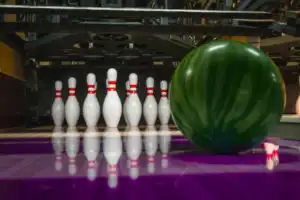The arrangement of bowling pins can vary depending on the location and type of game you’re playing.
In ten-pin bowling, the pins are consistently arranged in a triangular formation. However, five-pin games assume a V-shaped arrangement to align with the unique play style.

Although the positioning of the pins can vary significantly, one constant in most games is the numbering of the pins.
Numbering pins serves a crucial purpose in certain games, as it can significantly impact the competitiveness and overall experience.
Get ready for the lowdown on PINs – the essential details you need to know. Discover why numbering them is crucial and how it impacts certain bowling games.
Contents
Why Are Pins Numbered?
There is a simple and unequivocal response to this inquiry: it greatly enhances the convenience of organizing the pins.
In a typical game of ten-pin bowling, each pin is assigned a number ranging from 1 to 10, indicating its position within the triangular formation.
This factor is typically not as significant for casual bowlers. However, experienced bowlers at a bowling center or tournament often use PINs to precisely communicate their target and aim. This practice ensures a clear understanding of the pin locations and desired outcomes.
Mastering the art of pin counting in bowling is a valuable skill that enhances your knowledge and expertise. By understanding the number of pins present and strategically aiming for specific ones, you can maximize your chances of knocking down the most with a single throw. This not only expands your bowling repertoire but also sharpens your ability to identify and target the more elusive pins.
Number Layout
In the standard game of ten-pin bowling, positioned prominently at the forefront of the triangular formation stands the solitary pin 1, affectionately referred to as the ‘Headpin.’
When aiming for a strike with a straight shot, bowlers often target this particular pin. By knocking it down, it has the potential to knock over the pins behind it, resulting in an impressive score.
Pins 2 and 3 are positioned in the second row, just behind the headpin. Typically, they are placed five boards away from the headpin, with pin 2 aligned with the 25 board and pin 3 on the 15 board.
The third row consists of pins 4, 5, and 6 on the 30, 20, and 10 boards, respectively. Pin 5 is commonly referred to as the ‘sleeper pin’ as it is obscured by the headpin and can be quite challenging to detect.
The back row is comprised of pins 7, 8, 9, and 10, arranged from left to right with 7 on the far left and 10 on the far right.
To ensure easy knockdown of the bowling pins, it is crucial to maintain a consistent spacing of 12 inches between each pin, evenly distributed across the triangular shape. This uniform spacing guarantees a precise hit for a perfect bowling experience.
Numbers In Nine-Pin Bowling
In nine-pin bowling, the numbers on the pins hold significant importance. The game involves a ‘red’ pin positioned in the center, which grants additional points if you manage to avoid hitting it while striking the other pins. This strategic element adds depth and excitement to the gameplay.
In the game of nine-pin bowling, the pins are arranged in a diamond formation, with the central pin, known as the ‘kingpin’, being pin number 9. This red pin holds great significance as it can greatly impact your score depending on whether you successfully hit it or not.
The remaining pins are positioned behind number 1, where it takes the lead. Numbers 2 and 3 follow suit, forming a sequential arrangement.
The middle row consists of the numbers 4 on the left, and 5 on the right, with the red 9 pin nestled in between them. Directly behind this row, you’ll find pins 6 and 7, while in the final row, there is pin number 8.
Although the width of the pins remains consistent in both nine-pin and ten-pin bowling, the nine-pins are typically longer. They can be strategically positioned farther apart to accommodate the game’s specific rules and adjustments.
Although nine-pin bowling once enjoyed immense popularity and had a captivating history, it has unfortunately experienced a significant decline in recent times due to certain regions banning the sport. Nonetheless, there are still centers and alleys where enthusiasts can indulge in this beloved game, particularly in various parts of Texas.

Why Is It Useful To Know Pin Numbers?
Learning the numbering system on the pins is a breeze! Remember that the headpin at the front is labeled as number 1. From there, the numbers progress from left to right for each row, all the way up to 10.
Although it may appear simple, this technique effortlessly enhances your game. Occasionally, when the pins are tightly clustered during gameplay, it can be challenging to discern the number of pins still standing. Implementing this approach can overcome this difficulty and improve your overall performance.
Being aware of the numbers that have already been eliminated can provide insight into the ones that are still in play, but perhaps less visible and more difficult to hit.
In a competitive setting like a tournament, familiarity with pin numbers becomes even more crucial. Announcers and coaches often refer to each pin by its number, so it’s advantageous to have these numbers memorized. This way, you can precisely understand what they are referring to and stay fully engaged in the game.
During tournaments, the number of pins knocked down by a player on each frame may even be displayed on scoreboards. This information is crucial if you aim to showcase your skills in a highly competitive environment. Enhancing the quality of your writing, optimizing word choice, structure, readability, and eloquence, while preserving the original meaning, is essential.
Wrap-up
Once you grasp the basic arrangement, recalling bowling pin positions becomes a breeze. However, their impact on the game can be significant, depending on your playing style.
While tracking your pins in ten-pin bowling can be useful, it becomes even more crucial in nine-pin bowling. The precise positioning of each pin has a significant impact on your final score, depending on how you execute your throws.
Successfully targeting the strategically placed pins and skillfully adjusting your technique to hit the sweet spot can make all the difference. As you carefully observe the arrangement of the pins, analyze their placement, and plan your approach, you can maximize your chances of achieving a satisfying strike or spare. So, next time you step onto the nine-pin bowling lane, remember the importance of pin tracking and how it can elevate your game to a whole new level of precision and success.
Hence, it is always beneficial to utilize pins as a reference, ensuring a clear understanding of the remaining pins and impressing your friends with the breadth of your bowling knowledge and expertise.


Allow me to introduce myself – I’m Eric Wilkinson, a true bowling aficionado. The world of bowling culture has always fascinated me, and I’ve made the exciting decision to share my passion through writing. As I embark on this blogging adventure, my goal is to provide fellow enthusiasts with valuable insights, tips, and captivating stories. Through my blog, I hope to ignite a deeper appreciation for the sport and foster a sense of community among fellow bowlers. Join me on this thrilling journey as we explore the vibrant world of bowling together.
